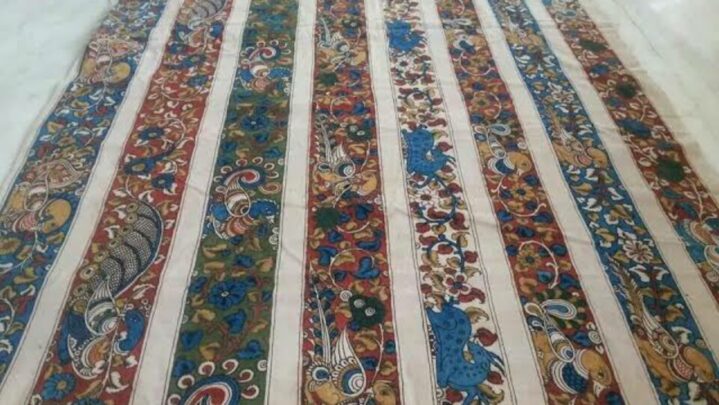Kalamkari is an old age method of hand painting using a tamarind pen on cotton or silk cloth using natural dyes. The word Kalamkari originates from the Persian word kalam, meaning pen, and Kari, indicating craftsmanship. hand painting, Dyeing, bleaching, starching, block-printing, cleaning, and other painstaking tasks are all part of this art. Peacocks, flowers, paisleys, and celestial characters from Hindu epics like the Mahabharata and Ramayana are among the many motifs depicted in Kalamkari. This skill is now largely used to make Kalamkari sarees.
Folk singers and artists used to roam from village to village, telling stories about Hindu mythology to the villagers. However, throughout time, the practice of narrating stories evolved into canvas painting, and this is when Kalamkari art initially came into being. This vibrant artwork goes back to about 3000 B.C. Fabric samples showing Kalamkari art have been discovered at the ancient ruins of Mohenjo-Daro, according to historians.
Kalamkari is created via a 23-step procedure. The entire operation, from the natural process of bleaching the cloth, softening it, sun drying, preparing natural dyes, hand painting, to the air drying and washing processes, needs precision and an eye for detail. Earthy colours like indigo, mustard, rust, black, and green are commonly used in kalamkari art. Natural dyes are extracted from natural sources without the use of chemicals or artificial substances in Kalamkari art. Craftsmen, for example, make black colour by combining jaggery, water, and iron filings, which they mostly employ to outline sketches. While boiling pomegranate peels produces mustard or yellow, madder or algirin bark produces red colours.
In India, there are two distinct kinds of Kalamkari art: the Srikalahasti style and the Machilipatnam style. Motifs are mostly printed with hand-carved traditional blocks in the Machilipatnam style of Kalamkari, with detailed detailing painted by hand. The Srikalahasti style of painting, on the other hand, is based on Hindu mythology and depicts scenes from epics and folklore. Because of its origins in temples, this style has a strong religious connotation.
Two new varieties of Kalamkari patterns have emerged in recent years, based on the states where they are made. Gujarat and Andhra Pradesh are two of India’s most important states for the production of two different types of Kalamkari patterns.
Also Read: Looking For Some Colour Combinations For Outfits In 2022? Look Inside





